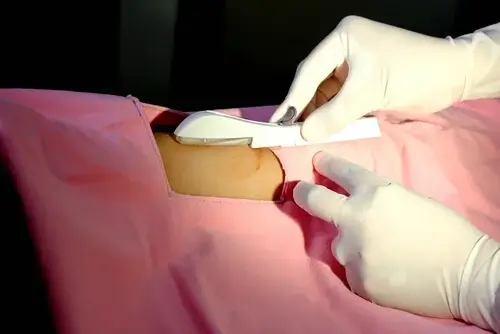Can I Get Pregnant if I Have a Progesterone Implant?

Within the wide range of contraceptive methods, one option that we have is the progesterone implant. In fact, this is one of the most requested, as it’s very effective. Below, we’ll detail everything there is to know about it.
Another of its most notable attractions is that it has a maximum duration of three years from its implementation. After this period, it must be removed or renewed.
Fear of this implant often has to do with its long-acting effect. While it’s true that many women who choose this method do so in order to avoid pregnancy, the fact that a contraceptive is so effective for so long – a time in which you may change your mind – is intimidating.
Despite this, the progesterone implant continues to be highly requested by the female population. Thanks to its use, a large number of women have avoided unwanted pregnancies.
This is reflected in the following figures, according to the World Health Organization: Of every 10,000 women who adhere to the progesterone implant contraceptive method, only 5 become pregnant. In other words, it’s 99% efficient.
The progesterone implant: What is it?
The progesterone implant consists of a small flexible rod that’s implanted subcutaneously with local anesthesia and that will release a constant dose of progestin.
At first glance, it may look like a matchstick. According to the Dictionary of the National Cancer Institute of the United States, progestin is defined as a “synthetic hormone that has some or all of the biological effects of progesterone”, which is a female hormone.
In other words, the progesterone implant is a concentration of six flexible plastic capsules or tubes of progestin that are inserted through a small incision in a woman’s dominant arm near the shoulder. The procedure must be carried out during the woman’s first menstrual days.

These implants are very effective as a contraceptive method, as well as the pill and condoms, but with the exception that it poses a much lower risk in terms of the possibility of pregnancy due to forgetfulness, inconstancy, rupture, or lack of use more traditional birth control methods. Subcutaneous insertion guarantees its action in consecutive cycles.
On the other hand, both the insertion and the removal of a progesterone implant consist of an outpatient procedure —generally performed by a gynecologist—, in a maximum time of approximately 15 minutes. Once removed, regular menstrual cycles should return within 3 to 4 weeks.
“According to the WHO, of every 10 thousand women who adhere to the contraceptive method of the progesterone implant, only 5 become pregnant”
Contraindications
The progesterone implant is totally contraindicated in the following cases:
- During pregnancy
- Patients with liver problems
- Women with irregular menstrual cycles
- Patients who have had breast cancer
- Women with undiagnosed vaginal bleeding
“The progesterone implant is a reversible contraceptive method”
Adverse effects
Some low-risk side effects have been associated with this method. In this way, although there may be unwanted effects, pregnancy isn’t a concern, as this method is more effective than many others, including tubal ligation.

Now, among the sequelae derived from the use of the progesterone implant, are the following:
- Acne
- Depression
- Ovarian cysts
- Headaches or migraines
- Breast tenderness
- Weight gain or loss
- Altered gastric pressure
- Hair growth or loss
- Infection in the insertion area
- It doesn’t work as a protection against sexually transmitted diseases (STDs)
These side effects are very rare. In addition, it doesn’t take long to overcome them; Experts have observed that when a woman suffers from any of these problems, they recover in a period of no more than three months.
However, in case of any irregularity, it’s important to consult a doctor and follow the suggestions that they indicate.
At the same time, it should be noted that no cases have been identified in which there is any type of consequence in the amounts of estrogen in the woman’s body.
Lastly, it’s quite common for there to be a decrease in menstrual flow, and even for menstruation to disappear in many cases. In this sense, the progesterone implant helps considerably to reduce and relieve premenstrual syndrome.
An article reports that in 2015 a study was carried out with users from Brazil, Chile, the Dominican Republic, Hungary, Thailand, Turkey, and Zimbabwe, and the change in the bleeding pattern was identified as the main reason for implant removal.
When is progesterone implant removal complicated?
As stated above, the extraction is done after three years, but it can be done earlier if the woman so wishes. The complication occurs when the implant isn’t palpable, which can occur for several reasons:
- Deep insertion
- Implant rupture
- Migration through vessels or deeper tissue
For these reasons, the nonpalpable implant must be located by ultrasound before the extraction procedure.
Within the wide range of contraceptive methods, one option that we have is the progesterone implant. In fact, this is one of the most requested, as it’s very effective. Below, we’ll detail everything there is to know about it.
Another of its most notable attractions is that it has a maximum duration of three years from its implementation. After this period, it must be removed or renewed.
Fear of this implant often has to do with its long-acting effect. While it’s true that many women who choose this method do so in order to avoid pregnancy, the fact that a contraceptive is so effective for so long – a time in which you may change your mind – is intimidating.
Despite this, the progesterone implant continues to be highly requested by the female population. Thanks to its use, a large number of women have avoided unwanted pregnancies.
This is reflected in the following figures, according to the World Health Organization: Of every 10,000 women who adhere to the progesterone implant contraceptive method, only 5 become pregnant. In other words, it’s 99% efficient.
The progesterone implant: What is it?
The progesterone implant consists of a small flexible rod that’s implanted subcutaneously with local anesthesia and that will release a constant dose of progestin.
At first glance, it may look like a matchstick. According to the Dictionary of the National Cancer Institute of the United States, progestin is defined as a “synthetic hormone that has some or all of the biological effects of progesterone”, which is a female hormone.
In other words, the progesterone implant is a concentration of six flexible plastic capsules or tubes of progestin that are inserted through a small incision in a woman’s dominant arm near the shoulder. The procedure must be carried out during the woman’s first menstrual days.

These implants are very effective as a contraceptive method, as well as the pill and condoms, but with the exception that it poses a much lower risk in terms of the possibility of pregnancy due to forgetfulness, inconstancy, rupture, or lack of use more traditional birth control methods. Subcutaneous insertion guarantees its action in consecutive cycles.
On the other hand, both the insertion and the removal of a progesterone implant consist of an outpatient procedure —generally performed by a gynecologist—, in a maximum time of approximately 15 minutes. Once removed, regular menstrual cycles should return within 3 to 4 weeks.
“According to the WHO, of every 10 thousand women who adhere to the contraceptive method of the progesterone implant, only 5 become pregnant”
Contraindications
The progesterone implant is totally contraindicated in the following cases:
- During pregnancy
- Patients with liver problems
- Women with irregular menstrual cycles
- Patients who have had breast cancer
- Women with undiagnosed vaginal bleeding
“The progesterone implant is a reversible contraceptive method”
Adverse effects
Some low-risk side effects have been associated with this method. In this way, although there may be unwanted effects, pregnancy isn’t a concern, as this method is more effective than many others, including tubal ligation.

Now, among the sequelae derived from the use of the progesterone implant, are the following:
- Acne
- Depression
- Ovarian cysts
- Headaches or migraines
- Breast tenderness
- Weight gain or loss
- Altered gastric pressure
- Hair growth or loss
- Infection in the insertion area
- It doesn’t work as a protection against sexually transmitted diseases (STDs)
These side effects are very rare. In addition, it doesn’t take long to overcome them; Experts have observed that when a woman suffers from any of these problems, they recover in a period of no more than three months.
However, in case of any irregularity, it’s important to consult a doctor and follow the suggestions that they indicate.
At the same time, it should be noted that no cases have been identified in which there is any type of consequence in the amounts of estrogen in the woman’s body.
Lastly, it’s quite common for there to be a decrease in menstrual flow, and even for menstruation to disappear in many cases. In this sense, the progesterone implant helps considerably to reduce and relieve premenstrual syndrome.
An article reports that in 2015 a study was carried out with users from Brazil, Chile, the Dominican Republic, Hungary, Thailand, Turkey, and Zimbabwe, and the change in the bleeding pattern was identified as the main reason for implant removal.
When is progesterone implant removal complicated?
As stated above, the extraction is done after three years, but it can be done earlier if the woman so wishes. The complication occurs when the implant isn’t palpable, which can occur for several reasons:
- Deep insertion
- Implant rupture
- Migration through vessels or deeper tissue
For these reasons, the nonpalpable implant must be located by ultrasound before the extraction procedure.
All cited sources were thoroughly reviewed by our team to ensure their quality, reliability, currency, and validity. The bibliography of this article was considered reliable and of academic or scientific accuracy.
- Castelo-Branco, C., & Valdés-Bango, M. (2020). Anticoncepción con solo progestina. Ginecología y Obstetricia de México, 88(S1), 56-73. https://www.medigraphic.com/pdfs/ginobsmex/gom-2020/goms201h.pdf.
- Fernándeza, C. G., & Revillab, J. M. F. Manejo de los Implantes Subdérmicos de Etonogestrel en Atención Primaria. https://archivo.revclinmedfam.com/PDFs/7eabe3a1649ffa2b3ff8c02ebfd5659f.pdf.
- Gomez, L. M., Giorgetta, R., Quartara, F., Lauria, W., & Rey, G. (2021). Efectos adversos y motivos de retiro de implante subdérmico Jadelle® en usuarias de Policlínica de Salud Sexual y Reproductiva del Hospital de Clínicas en período junio 2015-diciembre 2017. Revista chilena de obstetricia y ginecología, 86(1), 68-75. https://scielo.conicyt.cl/scielo.php?pid=S0717-75262021000100068&script=sci_arttext&tlng=en#B10.
- Rodríguez, R. R., Goya, A. E., & Fernández, J. N. (2021). Retirada de implante anticonceptivo no palpable. Atencion Primaria, 53(8). https://www.ncbi.nlm.nih.gov/pmc/articles/PMC8220182/.
- Gómez-Fredes Paula, Pierucci Alejandra, Martín Nicolás, Urquiola Cecilia. Migración de implante anticonceptivo subdérmico a rama segmentaria de la arteria pulmonarMigration of subdermal contraceptive implant to segmental branch of pulmonary artery. Rev. argent. radiol. [Internet]. 2022 Abr [citado 2022 Dic 09] ; 86( 1 ): 70-72. Disponible en: http://www.scielo.org.ar/scielo.php?script=sci_arttext&pid=S1852-99922022000100070&lng=es. Epub 04-Abr-2022. http://dx.doi.org/10.24875/rar.m22000005.
This text is provided for informational purposes only and does not replace consultation with a professional. If in doubt, consult your specialist.








